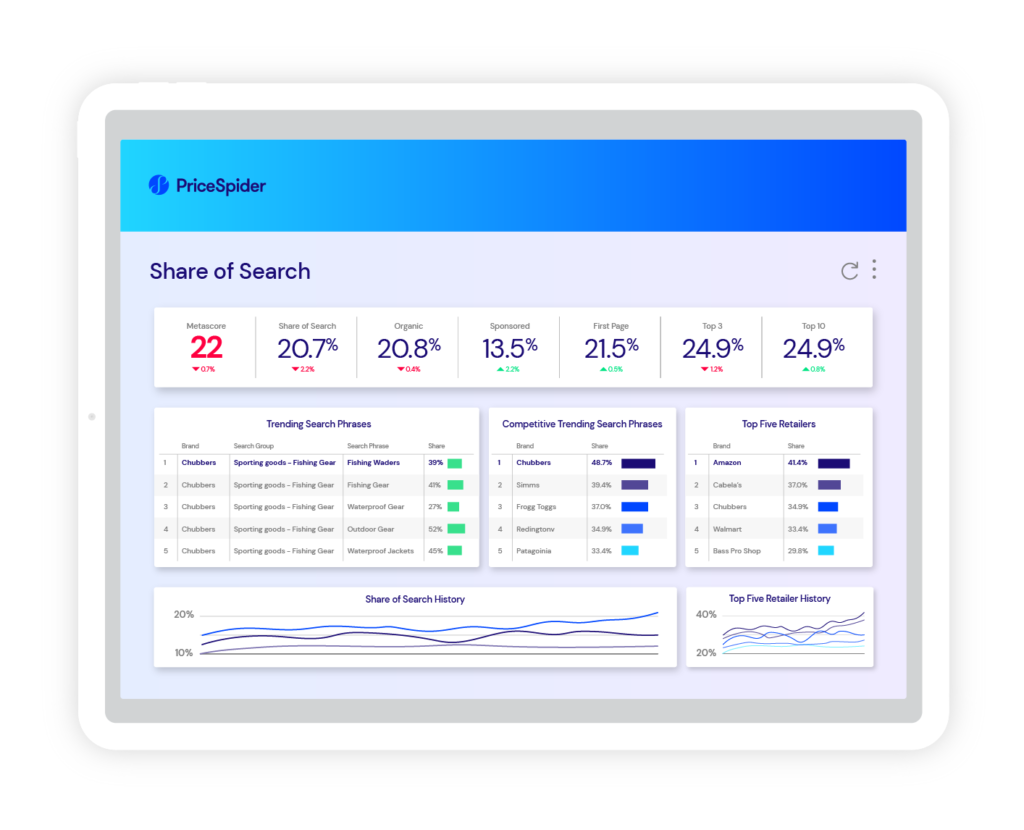Diet fads, DIY shows, fitness gurus, and self-help books. As a species, it’s almost like our brains are engineered to seek improvements over and over again. Sometimes it takes some of us longer to recognize or act on those improvements, but eventually the writing is on the wall and we succumb to the desire to be better. While not all of us are ready to go full keto, become the next Chip and Joanna Gaines, or get heavily into protein like the Liver King, getting to the end result does start with baby steps. We’re going to get you started by walking you through four simple ways you can impact the performance of your digital shelf data quickly.
Sometimes when sales are down, it’s hard to know what’s at fault. And on the digital shelf, countless factors can influence where your products show up and how well they do in comparison to your competitors. But with the right tools, you’re not in the dark. Thankfully, there are things you can do to start improving your digital shelf performance right now using digital shelf measurement tactics.
Here are some of the first places to start.
1. Analyze your Share of Search
If consumers don’t see your products when they look for your category, it’s no wonder they aren’t buying! Most people only browse the first few results, so brands that aren’t on the first page don’t stand a chance at winning sales in their category.
Here’s where things get more complicated: consumers use multiple search terms to find the same kinds of products. How they look for you depends on their region, dialect, familiarity with the category, and preferences. And while search engines are getting better at recognizing what people are really searching for, they’re still usually going to serve up the product pages that look like the closest match to what someone is looking for.
And the most frustrating part? You don’t know which terms people use the most or how often they use them. So if you go “all in” on a keyword you think is the most popular, you might lose more than you gain.
To win the digital shelf, you need to monitor your rankings for each of the keywords that matter to each of your products—on every retailer’s site. That’s a lot to keep track of, but with Brand Monitor, it’s effortless. (And much more valuable). Brand Monitor’s Share of Search feature automatically tracks your products’ positions for the keywords that matter to you all contained within an efficient digital shelf software solution.

Over time, you’ll build a crucial lens into the performance of your digital shelf data. You can see which keywords your rankings have fallen in, when you got replaced, and who replaced you. And if that decline in rankings coincides with a sharp decline in sales, then you know which terms are most important to optimize for.
You can also use Share of Search to spy on your competitors. What terms are they advertising for? How are their rankings doing over time? These insights could lead you to discover new terms to target.
2. Audit your sellers’ content
Inconsistent product assets lead to inconsistent performance. You want your product pages to perform their best? Make sure your sellers comply with your brand guidelines. You work hard to make sure your pages have the best titles, descriptions, images, videos, and supporting content. If a seller doesn’t include these assets or fails to update them, they’re holding you back. (Not to mention, it hurts your return-on-investment on the assets.)
You could manually examine your product pages, opening a tab for every seller and comparing them to a master copy of your brand guidelines for each product. Or you could let Brand Monitor do it for you. Brand Monitor’s content compliance feature automatically compares every page that sells your SKUs to a copy of your guidelines, then gives each page a score based on how well it follows your guidelines. It checks every section of copy and uses image recognition to identify the images and videos and determine if they’re in the correct order. If anything is amiss, you’ll know.

3. React to stock availability
If you’re not turning ad campaigns on and off based on stock availability, you’re hurting your digital shelf optimization and performance in two ways.
First, any time your products are out-of-stock, your customers can’t buy them. So it’s a huge waste to advertise on keywords to drive people to these product pages. Before someone even clicks through to your product page, a retailer may present a callout that says it’s out-of-stock. Your clicks will tank, and so will conversions. Why not just turn off the ads and put that ad budget to work somewhere else?
And second, when your competitors are out-of-stock, it’s one of the only times it’s actually worth it to advertise on their branded search terms. Faced with an out-of-stock notice, their customers are left with three choices:
- Leave to buy somewhere else
- Buy nothing
- Buy something else
Some people are willing to buy the best alternative they can find. And with a timely ad campaign, you can show up in those branded search results and position your product as that alternative. You’ll be the first in-stock product they see in the product category they need.
Brand Monitor lets you track stock availability on your own products and your competitors, so the moment stock status changes, you can turn your ad campaigns on or off in response.
4. Respond to reviews
You can learn a lot from product reviews. Prospective customers can, too. If they consistently see negative reviews talking about the same problems, they’re going to believe those criticisms are true about your product, your brand, or the kind of experience they can expect after making a purchase.
You can change that. Responding to reviews involves both replying to the reviewer and addressing the problem.
Replying to negative reviews is an opportunity to potentially win back a frustrated customer (or at least smooth things over), but more importantly, it’s a chance to show potential customers that you’re a legitimate brand, that you’re listening, and that they can hopefully expect a better experience than the reviewer had.
Obviously, if negative reviews highlight a legitimate problem with your product or your messaging, you should work to resolve that. It might be an issue with your supply chain, a product defect, or an unfulfilled promise in your supporting copy. Address these problems, then reply to the negative reviews, or if it makes sense, incorporate the change into your product page copy.
With Brand Monitor’s Ratings & Reviews tool, you can see the sentiments and keywords that arise from your reviews on a single site or view aggregate reviews from across the web. You can also isolate date ranges to see what people said during promotions, holidays, or other periods that matter to your brand.
Don’t settle for poor performance
For over 20 years, PriceSpider has been building tools to help brands earn more sales, create better experiences, and discover deeper insights into their performance. Brand Monitor is the most advanced digital shelf analytics software available. With this single solution, you’ll get the tools you need to analyze your digital shelf data and performance and make meaningful changes.
Want to see what Brand Monitor can do for your brand?

